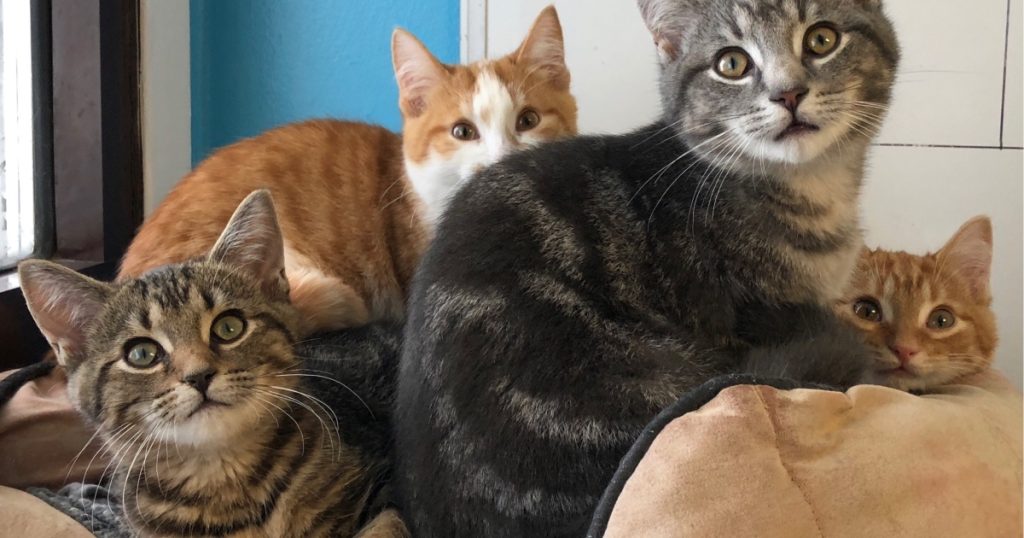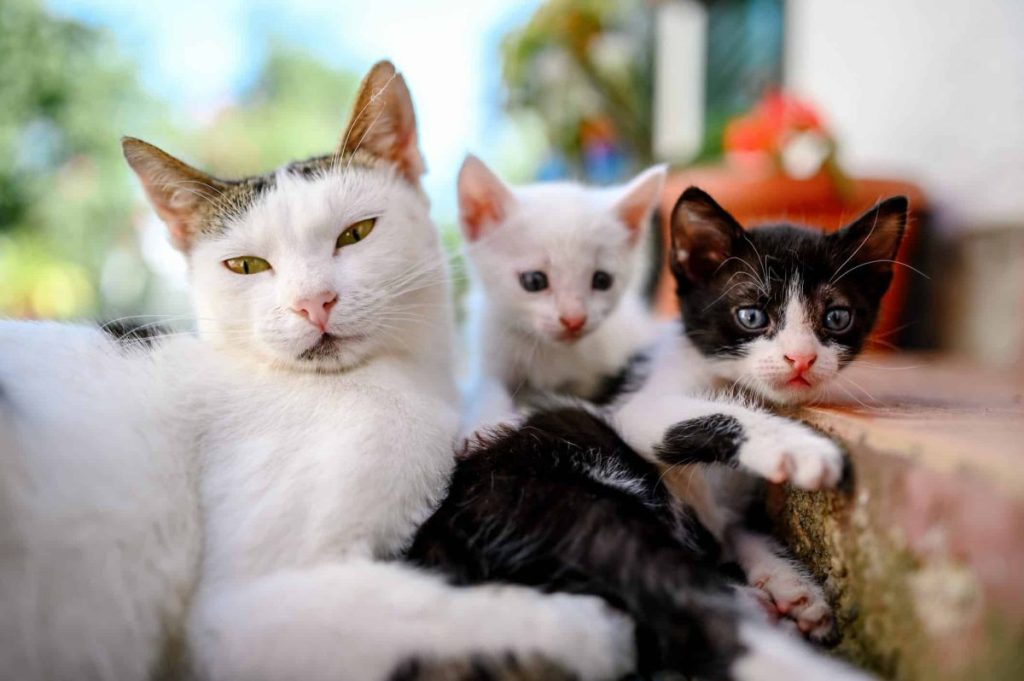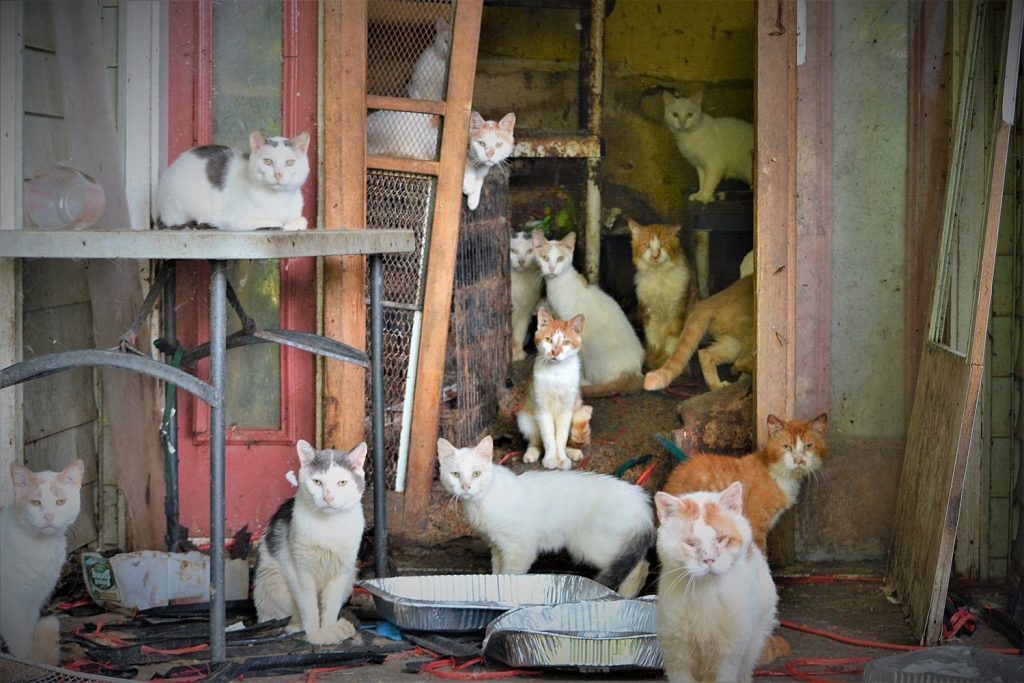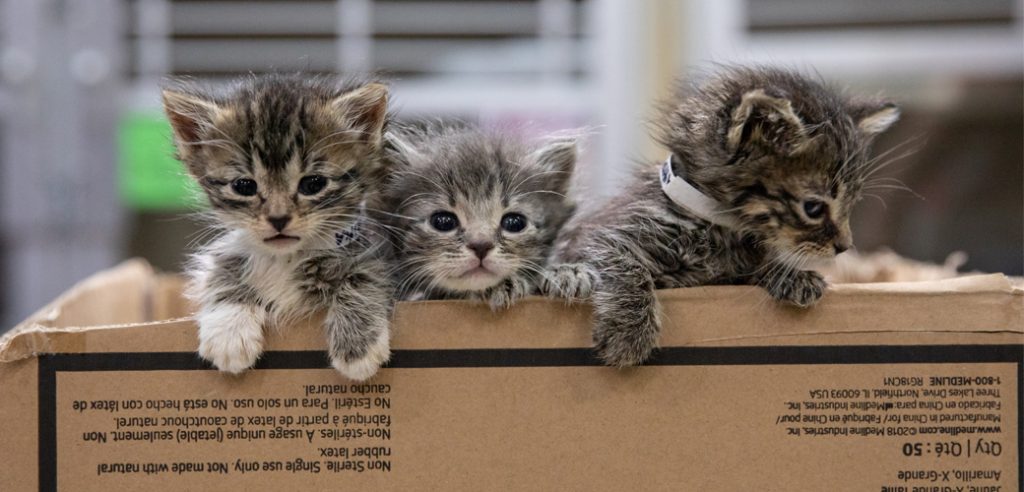The character of the crazy cat lady who lives alone in her apartment with a bunch of cats is no longer necessarily used as a negative stereotype these days. On the contrary, some people even celebrate this lifestyle on the internet and in pop culture. But when does such a love of cats become more than just a bizarre personality trait? When does it become worrying, dangerous or even deadly?

If several cats live in a house, it is important that their basic needs are met – for example that they have enough space. Laura Cassiday , certified cat behavior consultant and founder of Pawsitive Vibes Cat Behavior & Training, tells us that these basic needs are also known as “The Five Freedoms of Animals.” These are divided into freedom from hunger or thirst, freedom from discomfort, freedom from pain or illness, freedom to express normal behavior and freedom from fear and suffering. If you can’t meet these basic needs as a cat owner, then you definitely have too many cats.
In this article you will learn more about how many cats are too many, when we speak of animal hoarding, and the problems associated with an excess of cats.
Table of Contents
How do you tell if someone has too many cats?
First of all, there is no concrete upper limit on how many cats a person can easily keep in their home. However, Cassiday gives us a guideline: In her experience, most people can take care of three or four cats fairly well.
Ultimately, however, this depends entirely on each individual’s individual requirements. Person A may only be able to care for two cats at a time if they have known each other for a long time and get along very well. Person B, on the other hand, may have no problems keeping five cats appropriately. In addition, some situational factors also determine how many cats a household can tolerate. This includes:
- The available space . If you have a smaller apartment – such as a studio apartment rather than a multi-story condo – you are more likely to have problems providing your cats with enough space and all the resources they need. If you even try to accommodate several cats in a rented single room, this will inevitably lead to conflicts.
- Other people, animals and children . Another important criterion is the number of other creatures that share the available space with the cats. If you live with several people and animals in addition to your cats, the cats inevitably have fewer resources available to them.
- State and local laws . If you rent an apartment or house, your landlord has probably imposed restrictions on keeping animals. Sometimes these restrictions only apply to animals of a certain size, breed or weight class. In other apartments you are only allowed to keep a certain number of pets. Individual states and municipalities also have the right to determine how many pets and what types of pets can be kept. In the USA, for example, some states have “cat codes” that impose certain obligations on cat owners, such as vaccinations for their cats or licenses to keep them. These laws vary from state to state.

5 signs you have too many cats
“The more cats you have, the more likely you are to experience some type of behavioral problem – such as urine marking or aggression between cats,” warns Dr. Mikel Delgado , certified cat behavior consultant, founder of Feline Minds and cat expert at Rover.
Fights between cats and territorial behavior such as urine marking are reliable signs that something is wrong. For more warning signs, see the following sections.
1. Malnutrition
As obligate carnivores, cats have very specific nutritional needs. Their food must provide them with certain vital vitamins, minerals and amino acids that are essential for a healthy body and a strong mind . For this reason, commercially available wet food and dry food are enriched with two particularly important amino acids: taurine and arginine .
Without these nutrients, cats are more susceptible to heart failure, blindness, seizures and ammonia buildup. So if cats don’t get enough food, they can suffer from severe malnutrition and die prematurely.
2. Chronic dehydration
In addition to malnutrition, improperly cared for cats that live in daily competition with other cats are more likely to suffer from chronic dehydration . Since cats are not genetically programmed to search for water on their own, you have to somehow make drinking more interesting for them so that they don’t become dehydrated. For example, you could set up a few water fountains in your house. Alternatively, you can feed them wet food so that they get the moisture they need from their food.
The average 10-pound cat should drink at least 8 ounces of water daily. If cats are chronically dehydrated, this can lead to organ failure, heart problems and neurological conditions.
3. Fleas and worms
It’s a myth that domestic cats can’t get worms and fleas. If cats do not receive proper flea treatment or are neglected, all it takes is one cat to bring these tiny, blood-sucking pests into the home and endanger all other cats. Fleas can cause itching, skin irritation, open wounds and fatal infections.
Kittens are particularly at risk of serious harm. Internal parasites such as roundworms can also be easily passed from cat to cat and even to her kittens through an infected mother’s milk. Untreated worms can cause life-threatening gastrointestinal problems and serious viral and bacterial infections in cats.
4. No strong bond with people
Cassiday explains to us that cats in unhealthy households are not sufficiently socialized and have not properly learned to live with other animals. Unfortunately, they have often missed the “critical” socialization period between two and seven weeks of age, leaving them fearful and suspicious .
According to the American Association of Feline Practitioners, a strong bond between cats and their human caregivers can improve the quality of life for everyone and reduce the likelihood of behavioral problems.
5. A bad smell in the home
A good sign that there are too many cats in a household is unhygienic living conditions. If someone doesn’t clean and disinfect cat litter boxes, bedding, toys, and food and water bowls adequately or at all, it can cause a number of problems. In addition to making the home dirty and smelly, this lack of hygiene promotes the spread of parasites, bacteria, viruses and diseases.
Some of these nasties can cross the species barrier and also infect humans , making both cat and human smelly and sick. If an excessive number of cats are crammed into an unclean living space and contaminate it with feces and urine smells due to their territorial behavior, an unhygienic home inevitably results.
Why is it bad to have too many cats?
Anyone who has many cats without adequately providing for their basic physical, social and medical needs will face a number of difficulties. In addition to the negative consequences we’ve already discussed – such as illness and other health risks – there are four other reasons why you shouldn’t have too many cats in your home:
Overpopulation
There are almost 40 million free-roaming cats in the United States alone. Cats can become pregnant as early as four months old and have two litters per year. This is problematic because many pet owners with a worryingly high number of cats do not have them spayed or neutered.

Delgado explains that these people buy their cats, often spayed or neutered, on platforms like Craigslist or pick them up straight off the street without providing them with regular veterinary care. That means these cats are reproducing more quickly, causing a mini-overpopulation crisis – which in turn feeds the larger, global crisis.
Reinforcement of behavioral problems
Cassiday tells us that competition for limited resources promotes behavioral problems in cats. Although cats in a crowded home have generally been well socialized with other cats, the socialization is not always positive. The crowding in small spaces and lack of resources cause these cats to become stressed and fight with each other. These fights can manifest themselves in three types of aggression : territorial and status aggression, as well as fights between individual cats.
Because these animals have not typically been spayed or neutered, this aggression is further exacerbated by their sex hormones, especially in non-neutered male dogs. While cats in stable households playfully fight with their roommates, cats in unhealthy households will scratch and bite each other in order to hurt the other. As a result, they can cause serious harm to their fellow animals and leave wounds that are susceptible to infection. People also risk catching bacterial infections like cat scratch disease if an aggressive, infected cat bites or scratches them so hard that the skin is broken.
Spread of diseases
In addition to parasites, fleas and bacterial infections, an unclean environment also promotes other infectious diseases. For example, feline immunodeficiency virus (FIV) and feline leukemia virus (FeLV) are highly contagious diseases that can be easily transmitted under these conditions. Because they attack cats’ immune systems, affected animals become more susceptible to other diseases and, if left untreated, can suffer lifelong painful symptoms. FIV is usually transmitted through bites, but can also spread through saliva during grooming, mother’s milk, and feces and urine in shared litter boxes.
Cat owners who create a healthy living environment for their animals typically work closely with their veterinarians to address their cats’ individual needs. So although FIV and FeLV are not curable , cats from healthy households can be treated effectively. Unfortunately, the outlook for cats who are hoarded with other animals by their owners and denied medical treatment is much bleeker.

Financial problems
If you house too many cats, you can quickly get into financial difficulties. Cats aren’t cheap. A single cat costs up to 1,500 euros per year for food, litter, toys, habitat enrichment and general veterinary visits – and that would only cover their basic needs. This amount does not take into account additional expenses such as dental cleanings, grooming, pet insurance and emergency vet visits, which can total up to 3,500 euros. So this means that caring for a single cat can cost over 5,000 euros per year.
With each additional cat you have to add the same amount again. Maintenance becomes even more expensive for cats with chronic illnesses that require frequent veterinary care, pregnant or older cats that require more food and have a variety of other special needs. The financial impact for a household with many cats can be devastating.
What special care requirements do cats who live with several others have?
Not all households with multiple cats are necessarily a bad environment for the animals. Delgado explains that having multiple cats can be a pleasant experience for everyone involved – if you take care of them properly. And how does it work? Whether the care needs of a home with multiple cats are met depends primarily on the resources available.
For example, according to Cassiday, an adequate number of litter boxes is a vital resource, but far from the only one. Other necessary elements to create an enriching environment include:
- Food bowls
- Water bowls
- Scratching posts
- Comfortable cat beds
- Cat trees
- Toy
- Human society
“If an item is important to a cat, he should have at least two of it,” advises Cassiday. She goes on to tell us that these items shouldn’t all be in the same place because cats want to protect their belongings from others, especially litter boxes, food bowls, and water bowls.
If you have too many cats, is that automatically considered animal hoarding?
When a person “collects” cats, it has many consequences for the animals and people. But first: What is meant by animal hoarding? To understand the effects of animal hoarding on cats, we must first clearly define the term.
According to the American Psychiatric Association, hoarding is a psychological disorder in which people are unable to part with items they consider valuable. This behavior typically presents itself in an extremely disorganized environment. When the “possessions” are cats, it is called animal hoarding. 72% of people who hoard animals are women and the most commonly affected animals are cats.
Of the 250,000 animals affected by hoarding each year , the majority are cats. How many cats can be considered animal hoarding? In the US, this varies from state to state, so there is no one-size-fits-all number. Instead of setting a limit, states define hoarding based on the condition of the home.
6 Steps to Find a New Home for Cats from an Overwhelmed Household
If you realize that you cannot meet the needs of a cat, the best solution is to look for a new home for it. The decision may not be easy, but the cat’s well-being comes first. “Many of these cats can be socialized and adopted into a new home,” Delgado explains. She tells us that you have to give the cats time to adapt to the new situation and give them as many positive interactions with people as possible. Additionally, a recent study found that administering medication may be beneficial in reducing the stress of shelter placement and making adoption more likely .
The first step to safely and ethically rehoming cats is to give them to a reputable organization – such as an animal rescue organization, a nonprofit rescue organization, or an animal shelter. If someone reports a case of animal hoarding to the police, the local animal protection authority will be contacted. This can decide where the cats go.

Once rescued cats are placed in their temporary housing, it typically takes six steps to find them a new home. These are:
1. Checking the cat’s health and behavior
The first and most important step before adopting a cat is to check its health. A veterinarian will examine whether she has been spayed or neutered and whether she has developed any problems as a result of hoarding, such as flea or worm infestation, malnutrition, dehydration, infections or illnesses. Different evaluation methods are then used in each organization to determine a cat’s temperament. This information will then help determine their needs and prepare them for adoption or life in foster care.
2. Medical treatment
In addition to treating illnesses, infections, and parasites, cats may also be spayed or neutered during this step . Malnourished cats receive a balanced diet with the necessary nutrients. If a cat’s fur is matted or full of fleas, grooming is now recommended. Once their basic survival needs are met and medical problems – some of which may have existed for years – are addressed, these cats begin to recover from their chronic stress and anxiety, allowing their true personalities to emerge.
3. Evaluate potential adoptive families
After relevant background information about the rescued cat has been posted on websites and shelters, the next step is to evaluate and conduct interviews with potential adoptive families. Potential new owners need to know what they are getting into and the special needs of the rescued cat. Maybe the cat needs to live in a house without children or other animals. Perhaps she would do best in a healthy household with several cats.
It is important to be clear about these and other requirements of the cat, as well as the responsibilities of the adoptive family. For unadopted cats, barn cat programs are an alternative to euthanasia, which some rescues are currently experimenting with. These cats are provided with food, safe housing and veterinary care by human caregivers, but are not kept indoors.
4. Arrange a first meeting
If you want to care for a cat or kitten, it’s not enough to fall in love with their photo or biography. Since all cats, like humans, have different personalities, there is a possibility that a particular human will not be a good match for a particular cat. “The most common challenge for previously hoarded cats is a lack of socialization toward humans,” explains Cassiday. So the best way to find out whether the chemistry is right is to meet a cat directly and spend some time with it.
5. Foster family
Adoption is not the only solution for a rescued cat. After assessing their welfare and behavior, it may be determined that a cat is best placed in a foster home. When a person decides to foster a previously hoarded cat, it becomes a form of exposure therapy or a crash course in human-cat socialization.
Very young kittens who are just going through the crucial socialization phase do well in such care situations. To support foster families, foster care programs exist to provide essential supplies such as food, toys, and litter, and to cover the cost of veterinary visits, making cat care more accessible to people who may not have the financial means to commit to it long-term to take care of a cat.
6. Sustained communication
Once a cat has been adopted or placed in a foster family, the cooperation with the animal shelter or adoption organization does not end there. At least for the first few months, staff at these institutions will likely have regular contact with the cat’s new caretakers. This checks whether the rescued cat has integrated well into its new household. On this occasion, the animal shelter staff can also support the foster family with advice if necessary or treat any problem behavior the cat may have. If these visits determine that the home is not suitable for the cat and no remedial measures work, a cat may need to be removed so that a better home can be found for it.